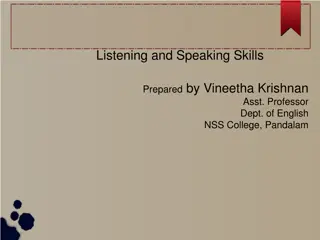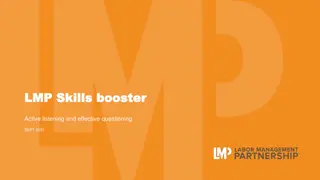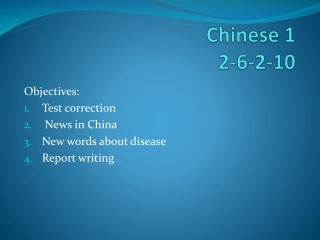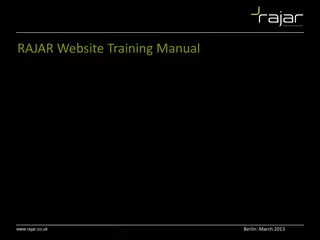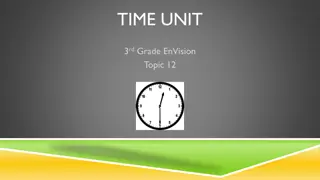
Your Business Data Is Telling You Something (And You Might Not Be Listening)
Where data whispers the secrets of success in the modern world, many businesses still struggle to tune in. Our latest blog delves into the hidden messages your business data is sendingu2014subtle trends, overlooked patterns, and silent signals that
Download Presentation

Please find below an Image/Link to download the presentation.
The content on the website is provided AS IS for your information and personal use only. It may not be sold, licensed, or shared on other websites without obtaining consent from the author. Download presentation by click this link. If you encounter any issues during the download, it is possible that the publisher has removed the file from their server.
E N D
Presentation Transcript
Your Business Data Is Telling You Something (And You Might Not Be Listening) The Silent Signals in Your Business Data Business data, often voluminous and complex, is a reservoir of insights that, when analyzed effectively, can reveal much more than just operational outcomes. The art of discerning subtle trends and patterns within this data is not just about processing numbers but interpreting what they signify about the future of a business. This skill is crucial in leveraging business reporting software and Business Intelligence (BI) reporting to their fullest potential.
Predictive Insights Through Anomalies Anomalies in data often go unnoticed but can signal crucial shifts in market dynamics or internal processes. For instance, a sudden dip in sales in a region might be attributed to external factors like weather or economic downturns. However, using advanced BI software, businesses can correlate various data points to discover more profound causes, such as changes in consumer preferences or increased competition. Such insights enable companies to respond proactively rather than reactively.
Pattern Recognition in Customer Behavior Changes in customer behavior are critical signals that can indicate both opportunities and threats. BI reporting software solutions allow businesses to track patterns over time, such as an increase in product returns, variations in buying habits, or shifts in service usage. Recognizing these patterns early on can help businesses adapt their strategies to retain customer loyalty and prevent churn. Operational Efficiency and Resource Allocation Inefficiencies in operations often manifest as minor discrepancies that are overlooked until they balloon into more significant issues. For example, a gradual increase in the production time of a bestselling product might indicate a need for maintenance or upgrades in machinery, which can be pinpointed through BI software. By addressing these inefficiencies early, businesses can save substantial costs and enhance productivity.
Financial Signals for Forecasting Financial data contains latent signals that, when decoded effectively using BI reporting software solutions, can forecast future financial health. Trends in expense categories, unexpected variances in budget forecasts versus actuals, or subtle shifts in cash flow patterns are vital for strategic planning. Understanding these elements can guide more informed decisions regarding investments, cost-cutting, and revenue optimization strategies. Examples of Commonly Overlooked Signals Seasonal Variations Misinterpreted Businesses often adjust for seasonal variations but miss subtle shifts that deviate from traditional patterns. These deviations, if observed using sophisticated BI reporting software, could unveil new consumer trends or market opportunities that aren't immediately apparent. Micro Trends in Social Media Engagement Social media generates vast amounts of data that are often underutilized. Sudden changes in engagement or sentiment on posts could inform content strategies significantly. Business Intelligence reporting tools can analyze these micro-trends to adjust marketing strategies swiftly and more effectively.
Supply Chain Delays Minor supply chain delays are sometimes dismissed as inconsequential. However, consistent patterns of delay, when analyzed through BI tools, can predict bigger issues upstream in the supply chain that could affect production schedules and delivery commitments. Common Barriers to Effective Data Listening Grasping data to drive insightful decisions is crucial in today's analytics-focused business environment. Yet, despite access to sophisticated Business Intelligence reporting and BI software, numerous businesses find it challenging to fully exploit their data. This underuse typically arises from a blend of technical and cultural hurdles, along with misunderstandings regarding the functionality and implementation of BI reporting software solutions. Technical Barriers to Data Interpretation
Complexity of Integration Many organizations face challenges with the integration of BI software into their existing systems. This complexity can deter businesses from adopting or fully utilizing business reporting software. Seamless integration is crucial for real-time data analysis and reporting, and difficulties here can lead to data silos and fragmented information landscapes. Data Quality and Consistency Effective data analysis requires high-quality, consistent data inputs. Issues such as incomplete data, duplication, or errors during data entry severely impact the reliability of insights gained from BI reporting software solutions. Businesses often underestimate the ongoing efforts required to maintain data integrity. Lack of Customization Generic BI solutions may not fit the specific needs of every business, leading to underutilization. The ability to customize BI software to align with unique business processes and goals is crucial. Without this, businesses may find the tools less helpful, impacting the adoption and effective use of Business Intelligence reporting.
Cultural Barriers to Data Utilization Resistance to Change
One of the significant cultural barriers is the resistance to change within organizations. Employees and sometimes management hesitate to adopt new technologies due to comfort with existing processes. This resistance can hinder the implementation of effective BI reporting software solutions. Data Literacy A fundamental barrier is the varying levels of data literacy across organizations. Without a basic understanding of data principles and BI software, staff may feel intimidated by Business Intelligence reporting tools, leading to underutilization. Increasing data literacy is essential for businesses to make the most of their BI capabilities. Misconceptions About Data Analytics "BI is Only for Large Enterprises" A common misconception is that BI software is only suitable for large enterprises with vast amounts of data. This myth can prevent small to mid-sized businesses from exploring BI reporting software solutions that could significantly enhance their decision-making processes. Overestimation of AI Capabilities While AI integration in BI tools offers substantial benefits, overestimating its capabilities without understanding its practical applications can lead to disappointment and mistrust in the technology. Businesses must have realistic expectations about what BI software and AI can achieve. Underestimation of Continuous Effort Another misconception is that once BI tools are deployed, they will automatically solve all data-related issues. In reality, effective data utilization requires continuous effort in data cleaning, analysis, and interpretation. BI reporting software is a tool, not a magic solution. Tools and Technologies That Enhance Data Listening Effective data analysis and interpretation hinge not just on the quality of data, but equally on the robustness and integration capabilities of BI tools. Let's explore the advanced tools and techniques that amplify data listening, with a focus on how integrating these solutions with existing systems can elevate data accessibility and usability for business users, data analysts, and BI professionals.
Key BI Tools Facilitating Effective Data Analysis 1. Advanced Analytics Platforms Modern businesses to delve deeper into their data. These platforms offer features like predictive analytics, machine learning, and real-time data processing, allowing users to forecast trends and make proactive decisions. Business reporting software within these platforms is designed to be user-friendly, ensuring that complex data insights are accessible to decision-makers at all levels. BI software provides comprehensive analytics capabilities, enabling 2. Data Visualization Tools Visualization is a powerful feature of BI reporting software solutions, making complex data sets understandable at a glance. Tools that offer dynamic dashboards and interactive reports help translate data into actionable insights. Whether it's heat maps, bar charts, or line graphs, these tools ensure that insights gained are not only accessible but also actionable. 3. Self-Service BI Tools Self-service BI tools democratize data analysis, allowing non-technical users to generate reports and insights without needing extensive training. This approach enhances data-driven decision-making across various departments, making BI more inclusive and broadening the scope of data utilization within the company. Enhancing Integration for Better Data Accessibility and Usability 1. Seamless Integration with Existing Systems The integration of BI tools with existing IT infrastructure is crucial for enhancing data flow and accessibility. BI software that can seamlessly connect with databases, CRM systems, and ERP systems ensures that all data sources are unified, providing a holistic view of business operations. This connectivity not only simplifies data management but also enhances the accuracy and timeliness of reports generated by business reporting software. 2. Cloud-Based BI Solutions Cloud technology plays a pivotal role in enhancing data accessibility and usability. Cloud-based BI reporting software solutions offer scalable, flexible, and secure data analysis opportunities. They allow businesses to access data insights on-the-go,
promote collaboration among remote teams, and reduce the overhead costs associated with traditional BI platforms. 3. APIs for Custom Integration Application Programming Interfaces (APIs) are critical for tailoring BI solutions to specific business needs. APIs allow BI tools to interact dynamically with other software, enhancing the capabilities of Business specialized functionalities and data from diverse sources. Intelligence reporting by integrating Conclusion The subtle conversations within your data hold transformative potential, often revealing hidden narratives about operational nuances, customer dynamics, and emerging market opportunities. Recognizing and responding to these faint yet critical signals necessitates not just insightful acumen but also robust technological support. At Grow, we specialize in amplifying these quiet data dialogues, equipping your team with the tools to transform subtle data insights into actionable intelligence. Our Business Intelligence platform is meticulously designed to democratize data analysis, ensuring that valuable insights are accessible to decision-makers at all levels of your organization. To genuinely appreciate the capability of Grow in refining your data listening processes, why not start with our 14-day complimentary trial? Engage firsthand with our intuitive tools that simplify complex data interactions and empower informed decision-making. Additionally, for an unbiased evaluation of our platform s impact, visit "Grow Cost & Reviews on Capterra." Discover how various enterprises are harnessing Grow to not just hear but effectively respond to their business data. Embark on your data-driven transformation today. Let Grow be your guide to navigating the nuanced symphonies of business data. Are you prepared to tune in?

